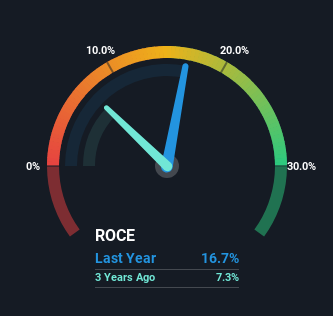- India
- /
- Construction
- /
- NSEI:RVNL
Rail Vikas Nigam (NSE:RVNL) Is Experiencing Growth In Returns On Capital
To find a multi-bagger stock, what are the underlying trends we should look for in a business? Typically, we'll want to notice a trend of growing return on capital employed (ROCE) and alongside that, an expanding base of capital employed. Put simply, these types of businesses are compounding machines, meaning they are continually reinvesting their earnings at ever-higher rates of return. With that in mind, we've noticed some promising trends at Rail Vikas Nigam (NSE:RVNL) so let's look a bit deeper.
What Is Return On Capital Employed (ROCE)?
For those that aren't sure what ROCE is, it measures the amount of pre-tax profits a company can generate from the capital employed in its business. Analysts use this formula to calculate it for Rail Vikas Nigam:
Return on Capital Employed = Earnings Before Interest and Tax (EBIT) ÷ (Total Assets - Current Liabilities)
0.17 = ₹25b ÷ (₹196b - ₹46b) (Based on the trailing twelve months to March 2024).
Therefore, Rail Vikas Nigam has an ROCE of 17%. In absolute terms, that's a pretty normal return, and it's somewhat close to the Construction industry average of 14%.
Check out our latest analysis for Rail Vikas Nigam

In the above chart we have measured Rail Vikas Nigam's prior ROCE against its prior performance, but the future is arguably more important. If you're interested, you can view the analysts predictions in our free analyst report for Rail Vikas Nigam .
So How Is Rail Vikas Nigam's ROCE Trending?
Rail Vikas Nigam is displaying some positive trends. The numbers show that in the last five years, the returns generated on capital employed have grown considerably to 17%. The company is effectively making more money per dollar of capital used, and it's worth noting that the amount of capital has increased too, by 97%. So we're very much inspired by what we're seeing at Rail Vikas Nigam thanks to its ability to profitably reinvest capital.
In another part of our analysis, we noticed that the company's ratio of current liabilities to total assets decreased to 23%, which broadly means the business is relying less on its suppliers or short-term creditors to fund its operations. This tells us that Rail Vikas Nigam has grown its returns without a reliance on increasing their current liabilities, which we're very happy with.
The Bottom Line On Rail Vikas Nigam's ROCE
A company that is growing its returns on capital and can consistently reinvest in itself is a highly sought after trait, and that's what Rail Vikas Nigam has. And with the stock having performed exceptionally well over the last five years, these patterns are being accounted for by investors. Therefore, we think it would be worth your time to check if these trends are going to continue.
One final note, you should learn about the 2 warning signs we've spotted with Rail Vikas Nigam (including 1 which doesn't sit too well with us) .
While Rail Vikas Nigam isn't earning the highest return, check out this free list of companies that are earning high returns on equity with solid balance sheets.
New: AI Stock Screener & Alerts
Our new AI Stock Screener scans the market every day to uncover opportunities.
• Dividend Powerhouses (3%+ Yield)
• Undervalued Small Caps with Insider Buying
• High growth Tech and AI Companies
Or build your own from over 50 metrics.
Have feedback on this article? Concerned about the content? Get in touch with us directly. Alternatively, email editorial-team (at) simplywallst.com.
This article by Simply Wall St is general in nature. We provide commentary based on historical data and analyst forecasts only using an unbiased methodology and our articles are not intended to be financial advice. It does not constitute a recommendation to buy or sell any stock, and does not take account of your objectives, or your financial situation. We aim to bring you long-term focused analysis driven by fundamental data. Note that our analysis may not factor in the latest price-sensitive company announcements or qualitative material. Simply Wall St has no position in any stocks mentioned.
Have feedback on this article? Concerned about the content? Get in touch with us directly. Alternatively, email editorial-team@simplywallst.com
About NSEI:RVNL
Rail Vikas Nigam
Engages in rail infrastructure works in India and internationally.
Excellent balance sheet unattractive dividend payer.
Similar Companies
Market Insights
Community Narratives




